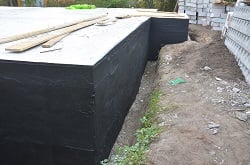
Imagine a homeowner going to collect their favorite holiday decorations from the basement, only to discover condensation, or worse, standing water. A wet basement or condensation issues are significant and valid concerns for homeowners. Whether the client expects you to be an expert in the matter or looks to you to solve simple issues, it’s important that you know some waterproofing basics.
While waterproofing applications should be designed to have a life as long as the building, this is often not the case because of damage, poor design, or incorrect execution. There are two application systems that are necessary to understand, therefore you can determine which system is best for each home or building.
Positive-Side Waterproofing. Positive-side waterproofing is loved because of its consistent effectiveness. Positive-side waterproofing protects the structural barrier from corrosive chemicals found in groundwater and puts a stop to the freeze-thaw cycle that can cause damage. Positive-side waterproofing can be installed after the foundation is set, and the system works by preventing water from entering the wall because of an established barrier. Materials that can be used to implement a positive-side system are fluid-applied membranes, sheet systems, hybrid systems, and bentonite clay.
Negative-Side Waterproofing. Negative-side waterproofing protects the surface opposite the inside of a basement wall. The water is therefore redirected if it enters. A negative-side system is more accessible which makes it easy to determine leak locations when compared to positive-side systems. Materials that can be used to install a negative-side waterproofing system are cementitious systems, acrylic additives, latex additives, and crystalline additives. These additives provide water protection by penetrating the surface.
If a system is put in place and water is later detected, here is the evidence you need to look for to determine waterproofing failure:
- Mold or Mildew
- Peeling Paint
- Rust Stains
- Unusual Odors
- Cracked Walls
- Rotting Wood
- Dampness
If any of these conditions are noticed, you must then look into the leak history of the home or building. Does the leak occur after using the washer in the laundry room or maybe anytime the region experiences heavy rain? Next determine the water source and location. After finding out where the leak is happening you can begin to resolve the leak and repair any damage.
Water damage can cause days of clean up or structural damage to a home, that’s why it’s important to know the basics and install correctly the first time around. One great way to limit damage from basement moisture is to use steel studs in your framing fastened with SCRAIK® STEELTHREAD® from BECK. They won’t rot, warp, or mildew in the presence of basement moisture which can save you a lot of hassle in the event of a moisture situation. Download our SCRAIL® STEELTHREAD® Brochure for more tips on how to get the job done!
.svg.png)

